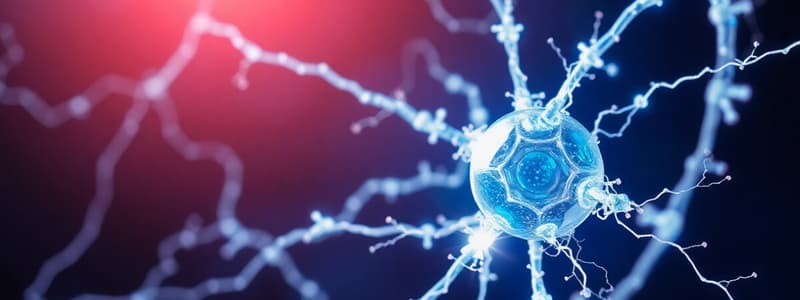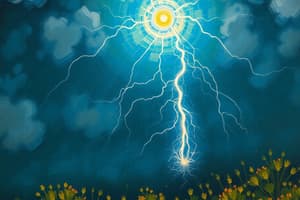Podcast
Questions and Answers
Which material has lower resistivity than iron?
Which material has lower resistivity than iron?
- Silver (correct)
- Aluminum
- Copper
- Nickel
A short circuit has high resistance.
A short circuit has high resistance.
False (B)
What charge do protons carry?
What charge do protons carry?
- Positive (correct)
- Negative
- Neutral
- Variable
What phenomenon occurs in certain materials at approximately -200°C?
What phenomenon occurs in certain materials at approximately -200°C?
Electric current flowing through the body can cause _____ or even death.
Electric current flowing through the body can cause _____ or even death.
Electrons are positively charged and protons are negatively charged.
Electrons are positively charged and protons are negatively charged.
What is the primary role of a fuse in an electrical circuit?
What is the primary role of a fuse in an electrical circuit?
What is the primary function of a lightning conductor?
What is the primary function of a lightning conductor?
Match the electrical components with their functions:
Match the electrical components with their functions:
In a series circuit, if one component fails, the _____ fails.
In a series circuit, if one component fails, the _____ fails.
Match the following terms with their definitions:
Match the following terms with their definitions:
Power is measured in _____, where 1 W = 1 joule per second.
Power is measured in _____, where 1 W = 1 joule per second.
Direct current (DC) alternates direction.
Direct current (DC) alternates direction.
Which statement about electric current is correct?
Which statement about electric current is correct?
Adding batteries in parallel decreases the voltage but increases battery life.
Adding batteries in parallel decreases the voltage but increases battery life.
What is the formula given by Ohm's Law?
What is the formula given by Ohm's Law?
Flashcards
Electric Current
Electric Current
The flow of electrons from an area of excess electrons to an area of deficit.
Resistance
Resistance
The tendency of an object to resist the flow of electric current through it.
Switch
Switch
A component that controls the flow of electricity in a circuit, typically allowing or blocking the flow.
Series Circuit
Series Circuit
Signup and view all the flashcards
Parallel Circuit
Parallel Circuit
Signup and view all the flashcards
Voltage
Voltage
Signup and view all the flashcards
Current
Current
Signup and view all the flashcards
Ohm's Law
Ohm's Law
Signup and view all the flashcards
Resistivity
Resistivity
Signup and view all the flashcards
Resistor
Resistor
Signup and view all the flashcards
Superconductivity
Superconductivity
Signup and view all the flashcards
Short Circuit
Short Circuit
Signup and view all the flashcards
Fuse
Fuse
Signup and view all the flashcards
Residual Current Device (RCD)
Residual Current Device (RCD)
Signup and view all the flashcards
Grounded Device
Grounded Device
Signup and view all the flashcards
Study Notes
Atomic Structure and Charges
- Atoms consist of protons (positive charge), neutrons (no charge), and electrons (negative charge).
- An atom is electrically neutral because the number of protons equals the number of electrons.
- Electrons transfer between materials during friction, creating static electricity. Objects with excess electrons are negatively charged; those with fewer are positively charged.
Static Electricity and Electric Current
- Opposite charges attract, and like charges repel.
- An electric current occurs as electrons move from an area with excess electrons to one with fewer.
- Lightning is the equalization of charge differences between clouds, within clouds, or between the ground and clouds. Lightning conductors safely guide strikes to the ground.
Voltage and Current
- A power source has positive and negative terminals. Conventionally, current flows from positive to negative, while electrons flow from negative to positive.
- Current is measured in amperes (A), and voltage is measured in volts (V).
- Conductors like metals allow current to flow due to free electrons; insulators like plastic and glass do not.
- A closed circuit is necessary for a device to function; an opened circuit halts the flow.
- Circuit diagrams use symbols to represent components.
Series and Parallel Circuits
- In a series circuit, components are connected in a line; failure of one component stops all. Voltage increases with more batteries in series; for example, 1.5 V + 1.5 V = 3 V.
- In a parallel circuit, each component connects separately to the power source; failure of one component doesn't affect others. Adding batteries in parallel maintains voltage but doubles battery life.
Electrical Safety
- Electrical current can harm or kill.
- A short circuit has little resistance, resulting in excess current and potential fire hazards.
- Fuses protect circuits by breaking the circuit when current exceeds limits. Overloading can cause fuse failure.
- Grounded devices utilize a specialized wire to direct stray current safely into the earth, reducing the risk of shock. Residual current devices detect unusual currents and quickly cut power to prevent accidents.
Magnetism and Electricity
- Magnets attract each other and certain materials, such as iron.
- Every magnet has a north and south pole; like poles repel, and opposite poles attract. Earth's magnetic south pole is near the geographic North Pole.
- Magnetic fields flow from north to south and are represented by field lines.
- Applying current to a coil generates a magnetic field; an iron core increases the strength. Turning off the current stops the magnetism
- Electric motors use current in coils within magnetic fields for rotational motion.
Induction and Current
- Moving a magnet into and out of a coil generates alternating current (AC).
- Alternating current changes direction; direct current (DC) flows consistently.
- Generators produce electricity by rotating magnets in coils.
- Transformers modify voltage levels using primary and secondary coils.
Electrical Energy and Efficiency
- Electrical energy is measured in joules (J); power is measured in watts (W), where 1 W = 1 J/s.
- Energy used equals power multiplied by time.
- LED lamps use less energy and last longer than incandescent bulbs.
- Power plants use high voltage to transmit energy efficiently, minimizing heat loss.
- Superconductivity is a lossless method for energy transport.
- Power = voltage x current
- A 10A fuse can handle 2300W; exceeding this trips the fuse.
Resistance
- Ohm's law states voltage = resistance x current.
- Resistance (measured in ohms) is the opposition to current flow. Resistance depends on material, thickness, length, and temperature.
- Different materials have different resistivities; for example, silver has lower resistivity than iron.
- Resistors reduce current in a circuit.
- Superconductivity occurs when some materials have near-zero resistance at extremely low temperatures (approximately -200°C).
- Filaments in incandescent bulbs have high resistance, causing them to glow when current passes through them.
Studying That Suits You
Use AI to generate personalized quizzes and flashcards to suit your learning preferences.
Description
Explore the fundamental concepts of atomic structure, including charges and static electricity. This quiz covers basic principles of electric current, voltage, and the behavior of electrons. Test your understanding of how these concepts interact in everyday phenomena like lightning.




